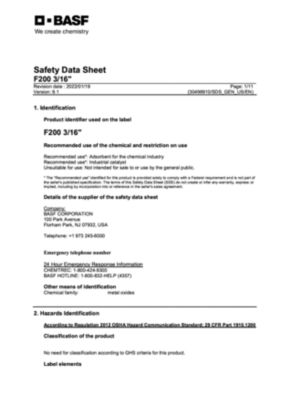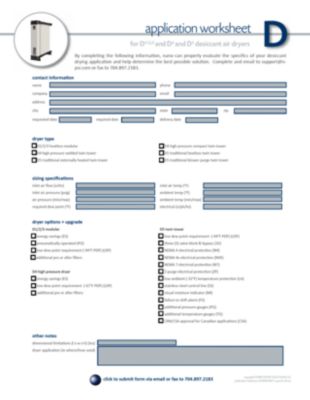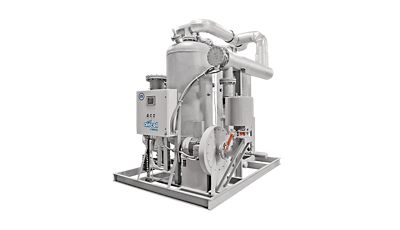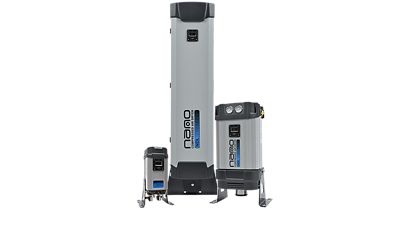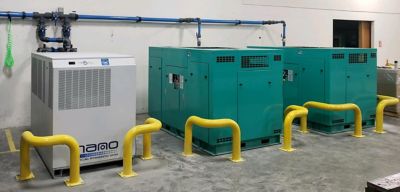Regeneration circuit is fully insulated for maximum efficiency, and specifically designed for a long and dependable operating life in harsh industrial environments.

Key Specs:
Flow Rate
150 to 3000 scfm
Connection
1” NPT (F) to 6” Flg
air quality
ISO 8573.1:2010
Product Documentation
- Brochures
- Electrical Diagrams
- Flow Diagrams
- General Arrangement Drawings
- Material Safety Data Sheets
- Worksheets
- With Pre & After Filters
- With Pre & After Filters Plus 3-Valve Pass
Features
A secondary heater contactor provides protection against overheating in the event of a primary contactor failure.
ASME code pressure vessels, UL/cUL compliant, made in the USA activated alumina, lifting lugs and/or fork lift pockets.
Specifications of Our Models
Externally Heated Desiccant Dryer Model |
Mounted Pre & After Filtration as Standard |
Inlet & Outlet |
Rated Flow at 100 psig |
Heater |
|
|---|---|---|---|---|---|
Prefilter |
After Filter |
NPT (F) / FLG |
scfm |
kW |
|
| EH 0150 | GFN 0175 M01 |
GFN 0175 M1 |
1" NPT (F) |
150 |
3 |
GFN 0325 M01 |
GFN 0325 M1 |
1 ½" NPT (F) |
250 |
4 |
|
| EH 0350 | GFN 0450 M01 |
GFN 0450 M1 |
2" NPT (F) |
350 |
6 |
GFN 0700 M01 |
GFN 0700 M1 |
2" NPT (F) |
500 |
7 |
|
| EH 0750 | GFN 0850 M01 |
GFN 0850 M1 |
2" NPT (F) |
750 |
11 |
| EH 1000 | GFN 1250 M01 |
GFN 1250 M1 |
3" Flg |
1000 |
15 |
| EH 1250 | GFN 1250 M01 |
GFN 1250 M1 |
3" Flg |
1250 |
18 |
| EH 1500 | GFN 1500 M01 |
GFN 1500 M1 |
3" Flg |
1500 |
22 |
| EH 2000 | NFZ 2500 M01 |
NFZ 2500 M1 |
4" Flg |
2000 |
33 |
| EH 2500 | NFZ 2500 M01 |
NFZ 2500 M1 |
4" Flg |
2500 |
37 |
| EH 3000 | NFZ 3000 M01 |
NFZ 3000 M1 |
6" Flg |
3000 |
45 |
Specifications |
Standard |
Optional |
|---|---|---|
Maximum particle size (ISO class) |
class 2 (1 micron) |
class 1 (0.01 micron) |
Maximum water content (ISO class) |
class 2 (-40°F pdp) |
- |
Minimum/ design /maximum operating pressure range |
Models EH 0150 to EH 1500 (70 psig / 100 psig / 180 psig) Models EH 2000 to EH 3000 (70 psig / 100 psig / 135 psig) |
58 to 250 psig |
Minimum / design/ maximum ambient temperature |
38°F / 100°F / 120°F | 20°F / 100°F / 120°F |
Minimum / design / maximum inlet temperature |
38°F / 100°F / 120°F | - |
Power supply requirements |
460V/3Ph/ 60Hz |
575V/3Ph/60Hz |
(1) This information is for general information purposes only. For additional technical specifications, refer to the product brochure, technical data sheets, and/or user guides. Technical specifications are subject to change.
Frequently Asked Questions
A nano EH Externally Heated Desiccant Dryer uses activated alumina desiccant material to remove moisture from compressed air. It operates using two towers that alternate between drying and regeneration cycles to ensure continuous operation. During the drying phase, compressed air flows through one tower, where the desiccant adsorbs moisture, allowing dry air to exit for downstream applications. Simultaneously, the other tower undergoes regeneration using a small portion of the already dried air, which is heated by an external heater and directed through the saturated desiccant to remove the accumulated moisture. The moisture-laden purge air is then exhausted to the atmosphere. After a set period, the towers switch roles, allowing continuous drying without interruption.
a. Determine required air flow (measured in standard cubic feet per minute, scfm)
b. Know your inlet conditions, as your dryer performance depends on the actual conditions of the air entering the dryer.
a. Inlet Temperature (°F)
b. Inlet Pressure (psig)
c. Ambient Temperature (°F) where the dryer is located
d. Select the required pressure dew point (PDP)
Dew point is the temperature at which air becomes saturated with moisture, meaning it can no longer hold all the water vapor it contains. When air is cooled to its dew point, water vapor starts to condense into liquid water. On a humid day, the dew point might be 65°F. If the temperature drops to that level overnight, dew forms on surfaces.
In compressed air systems, if the dew point is higher than the pipe or ambient temperatures, condensation will form inside the system, leading to corrosion or contamination.
Pressure Dew Point (PDP) is the temperature at which water vapor begins to condense into liquid at a given system pressure (not atmospheric pressure). It's a key measure of how dry compressed air is.
In compressed air systems, moisture is your enemy; it causes:
- Corrosion in pipes and tools
- Malfunction of pneumatic equipment
- Product contamination (especially in food, pharma, electronics)
To prevent this, we remove moisture until the air reaches a safe dew point, the lower the dew point, the drier the air.
Yes, climate and environmental conditions directly affect the amount of moisture in the air and the risk of condensation in your compressed air system. This, in turn, impacts the dew point you need to avoid moisture-related issues.
Hot & Humid Climates
- Higher ambient humidity means more water vapor in the air.
- You’ll need a lower dew point to remove moisture and avoid effectively:
- Water buildup in lines
- Corrosion
- Product contamination
- Typical PDP required: -40°F (or lower for sensitive applications)
Cold Climates
- Moisture can condense and freeze in outdoor lines or exposed piping.
- Even if the air contains less moisture, freezing becomes a concern.
- A dew point lower than the coldest ambient temperature is essential.
Rule of thumb: Set PDP at least 20°F below the lowest ambient temperature the system will encounter.
The EH Externally Heated Desiccant Dryer provides a standard pressure dew point (PDP) of -40°F, which corresponds to approximately 0.1% relative humidity at room temperature, suitable for most industrial applications.
Yes, the units have an electric heater for regeneration and a PLC that requires electricity.
Typically, 8% of the dried air is used for regeneration.
The following features are included as standard in nano-purification solutions' EH Externally Heated Desiccant Dryer:
- NEMA 4X control panel
- Mounted pre and after filters
- Adjustable purge valve
- UL/CUL compliant
- Premium controller
- Dew point display
Optional features and accessories of nano's EH Externally Heated Desiccant Dryer include:
- Various bypass options
- Electrical protection upgrades (NEMA 7, Z-purge).
- Stainless steel control tubing.
- Low ambient temperature protection
- Visual moisture indicators.
- Run time hour meters.
- Additional pressure and temperature gauges.
Yes, the EH Externally Heated Desiccant Dryers are equipped with corrosion-resistant NEMA 4X electrical enclosures as standard, making them suitable for outdoor and harsh environments. However, additional modifications, such as a low ambient package and stainless steel control lines, are often recommended to ensure optimal performance and durability in extreme conditions.
Yes, all EH Externally Heated Desiccant Dryers undergo comprehensive quality assurance procedures, including complete functional testing, pressure and leak testing, and control system verification before shipment. This ensures each unit meets performance specifications and is ready for reliable operation upon installation.
The following maintenance is required for the EH Externally Heated Desiccant Dryer:
- Desiccant replacement (every 3–5 years depending on use)
- Filter (control air, inlet and outlet) & Muffler annual replacement
- Valve inspection
- Checking for desiccant dusting or channeling
The cost varies depending on the flow rate and PDP required for your compressed air system. Contact us today for a personalized quote.
Period: 18 months from date of shipment from the factory or 12 months from date of installation/start up, whichever occurs first • Coverage: 100% parts and labor per defined service time allowances • Extended coverage: Inlet & purge exhaust valves: 5 years from date of shipment (parts only)




































